Antonio Najarro: "Each skater is a different world"
ÂJuly 12, 2010
By Reut Golinsky
Photo © Antonio Najarro, Reut Golinsky
 He is one of the most prominent representatives of Spanish dance and Flamenco, in Spain as well as outside. For the skating world he is the choreographer behind the golden Olympic original dance of Marina Anissina and Gwendal Peizerat in 2002. And for me he is first of all the creator of the program which triggered my interest in figure skating, impelled me to go to Cup of Russia in 2007 to watch this program performed live, and brought me to where I am today; traveling all over the world and writing about figure skating.
He is one of the most prominent representatives of Spanish dance and Flamenco, in Spain as well as outside. For the skating world he is the choreographer behind the golden Olympic original dance of Marina Anissina and Gwendal Peizerat in 2002. And for me he is first of all the creator of the program which triggered my interest in figure skating, impelled me to go to Cup of Russia in 2007 to watch this program performed live, and brought me to where I am today; traveling all over the world and writing about figure skating.
Antonio Najarro presented his show "Jazzing Flamenco" during the "MadriDance" festival held in June at the Suzanne Dellal Centre in Tel Aviv. Needless to say I was curious to learn about his "off ice" work and was absolutely mesmerized by what I saw. I also used this opportunity to meet Antonio and talk to him about his recent projects with top skaters, and other skating related topics. His knowledge and understanding of skating was amazing to see, and his passion and concern about its development was bigger than I expected from a person who doesn't wear skates and whose main field of interest is pretty far from the ice...
Antonio, one of the biggest news this off season is your work with Jeremy Abbott and Brian Joubert. How did it start?
They called me. I've worked with skaters since 2002 (Anissina /Peizerat). Ever since then skaters have been very interested in my work, which has a different approach: I try to treat skaters as real dancers. I work with them a lot in a studio, away from the ice.  And I think the audience sees the difference; that the skaters are not only doing a few steps or some movements, but they move like real dancers. And I study the personality of each skater because they are completely different.
And I think the audience sees the difference; that the skaters are not only doing a few steps or some movements, but they move like real dancers. And I study the personality of each skater because they are completely different.
And some of them are hard to imagine skating "Spanish style" programs...
Skating fans are always judgmental. They see Brian Joubert, who is more of a solid skater, and they immediately say: "No, no, he can't do this". But it's not true. I think a good choreographer is one who can identify the style of each skater, and then create a flamenco program, or something else because I also do other styles, specifically suited for his personality. This is what makes a good choreographer. Not the ones who create steps and arm movements and positions, but do the same thing for all the skaters. You have to know the skater: his personality, his style of moving, his capacity and then create the right choreography for him.
How do you have time to get to know them and their personality? You only spent a few days with Jeremy in the USÂ…
With Jeremy I knew it from the first day but I had also seen him skate before. The first day we spent about four hours in the studio and I was teaching him a lot of flamenco movements. My flamenco is very contemporary, like you saw in my show. It is not a pure flamenco, and there are many different dance styles in it. In just one hour I can already understand a lot about the skater, because the whole personality of the skater reflects in his movements. It's the same with dancers; the way you are as a person reflects in how you dance, always.
From Jeremy's movements alone I couldn't tell he is a passionate person.
You will see it in his new program! (smiles)
For example, with Brian, he is manlier on the ice, he is strong. That makes my task easier because flamenco men are always very virile and masculine. But it's harder for him to work on movements. Jeremy is more ductile, more fluid. For him it's more difficult to be strong, but on the other hand he is capable of doing more complex choreography, like move in a very different way, with contemporary movements. For him I made the choreography very rich with movements, while for Brian I did something simpler, but stronger. So they are completely different skaters and I have to know how to react to each skater. For example, when I created flamenco for Lambiel; he was very strong artistically; he is a very good dancer. I tried to change his style to be more masculine. It was a different vision, because he normally showed more classical programs. Each skater is a different world.
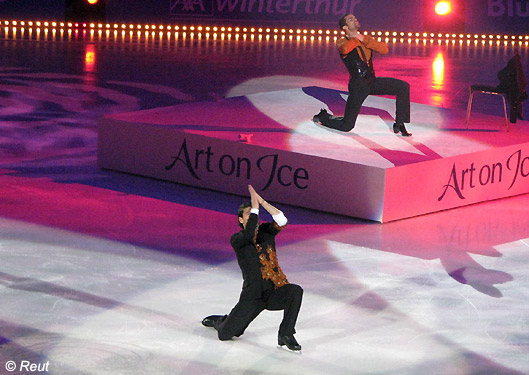
Have you ever refused a skater because you believed your dance style wouldn't suit him?
No, never. I can do many things. I am a choreographer, not only a flamenco choreographer. Flamenco is my first language, but since I was five I've studied classical dance and contemporary dance.
I think I know what is missing in the skating world. Because of all the rules and technical requirements, like jumps and spins, we always forget what is the most important in skating; the personality of the skaters. In the end it's the personality the audience remembers. If you check which skaters are really beloved and remembered in the skating world, these are the skaters with personality. Why do people remember the flamenco program of Anissina and Peizerat? Because of the choreography, yes, but most of all because of their personalities! People will remember Stéphane Lambiel for his personality too. For me that's the most important thing. Someone can be an amazing skater, who can jump and all, but in the end people will remember how he acted on the ice, the way he moved, his feelings, his costumes, his music.
And through your choreography you help to show this personality?
Yes. I try to help each skater develop the emotions inside of him. I always start with movements. Movements, movements, movements. On the third day I start to work on the emotions. Each movement must have an emotion, movements without emotions are nothing. But emotions without technique are nothing either, all must be put together.
 Usually I meet with my skaters two or three times during the season. My choreography is complex and it's very hard for them to assimilate all the movements at once. So with Jeremy and Brian, I will work with them again in August and maybe also just before their competitions start.
Usually I meet with my skaters two or three times during the season. My choreography is complex and it's very hard for them to assimilate all the movements at once. So with Jeremy and Brian, I will work with them again in August and maybe also just before their competitions start.
Do you follow "your programs" during the competitive season?
Always. I always try to go to the competitions with the skaters, but sometimes I am busy with my dance company. But when I can I always try to be with them during the competitions because I think it's very important to see them competing. It's completely different [from training]. And I try to help them although I'm a dancer and dance is a different world, but I know what it is like to be on the stage.
This season you work with Jeremy and Brian, who are rivals. They will use the programs you've created and fight for the same medals and placements.
Yes, I know. But before I say "yes" to skaters who want to work with me, I check what kind of skater they are. If they are very similar, I won't accept, or maybe I will chose only one to work with. But there is a huge difference in skating and style between Jeremy and Brian. So I know the programs will be completely different though obviously you will see my touch. I know they will compete against each other and I will help both of them. And because they are different, they will show different choreographies so people won't say: "Oh, we don't know [who to choose], they are exactly the same." And by the way, by chance they are both doing the short program with me and the long program with David Wilson.
This year I also work with two French dance teams: Pechalat/Bourzat and Carron/Jones. They are still young but they will be very, very good dance teams. A month ago I went to Moscow for a week and I worked with Nathalie and Fabian on waltz and tango, which they mix for a Short Dance. The choreography for the tango will be very powerful. Zhulin was there too and he was happy with my work with them.
With Pernelle and Lloyd we worked in Lyon. I work a lot in Lyon with Romain [Haguenauer] and Muriel [Boucher-Zazoui]. For them I created a very different version of a famous rock song mixed with a well-known orchestra piece.
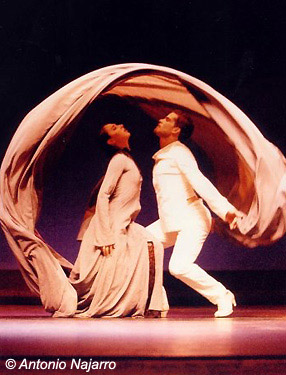 Do you choose the music for the programs or do the skaters bring it?
Do you choose the music for the programs or do the skaters bring it?
For Stéphane I chose all the music pieces. Some of them were used in my shows. Jeremy's music is also from one of my shows. For Brian it's Malagueña, a very different version with metal guitars, very strong. He showed me the music and asked my opinion, and I liked it. So Brian chose his own music.
In your show the costumes seem to be part of the choreography, like the very long skirts and transforming dresses. Do you bring your ideas of costumes to the skaters?
I create many of the costumes. Stéphane had his costumes made in Madrid, with my designer. Jeremy and Brian have been offered designs from Madrid as well, but have yet to decide. Of course costumes are very important. I cannot choreograph and not care about the costumes. All must be in the same package. I'm not the kind of choreographer who comes, does the choreography and leaves, no. I like to come, speak about music, costumes, hair style, about everything. If I start the work I like to see the results and improve them.
While choreographing skating you're limited, you have but little control over leg movements, and you don't have those significant flamenco steps. Are there still benefits in skating that you usually don't have in dance?
Of course, the possibility of speed, we don't have it. The possibility of spinning; the dancer who can do seven revolution pirouettes is considered an amazing dancer. In skating it's completely different. For me it's an advantage, because I can put some interesting slow movement of arms during the spinning. I can also put jumps in the programs.
In Spain I'm known as a choreographer who uses the arms a lot. Normally, in the world of flamenco the choreography is more focused on the feet. But like you saw in my show; I use the arms, the headÂ… Of course the work I do with the skater in mostly with the upper body, but I also try to make steps similar to dance. They can't be the same, but I try at least to put the same energy into the steps, the same intensity.
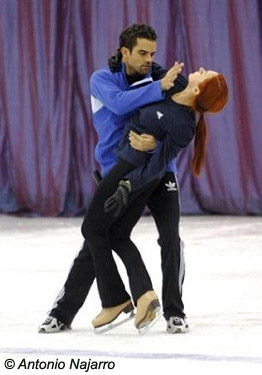 Do you skate yourself?
Do you skate yourself?
Yes, but not a lot, I don't want to risk it. It's very dangerous for me as a dancer and I have to be careful. So I never put the skates on when I choreograph, but I am always on the ice with the skaters.
Knowing how to skate should give you a better understanding about the movements on the ice and the complexity of skating.
Right. Skaters, before they work with me, are often a bit afraid because I'm not a skater myself. But I always say: I have a "dancer's vision". I work with skaters on a very high level and who, I think, don't need a skater to show them the choreography. This is my opinion. They will progress much better with a real dancer, a real dance choreographer. There are amazing choreographer-skaters, of course. I don't want to say that they are not... But they will always see the choreography in a "skater's vision". They will always put the movement in according to the skating steps. They will always think: "That's a very difficult step, so I can't put something difficult for the arms", while I always take that risk. For example, when I see a step sequence, I think about the upper part of the body and add the movements I would for a real dancer. It's extremely difficult for a skater, because there must be a lot of coordination of the arms. But the result will always be: "Wow, he is a dancer on the ice!"
But this might make a program impossible to perform!
In the end it's possible. I push a lot and I also talk a lot to the skaters to make them believe in themselves. And to go, go and go with more difficult movements. I think this can bring an evolution to skating. If we have rules, the same rules for every skater, the same jumps for every skater, in the end you'll see carbon copies. And I think it's important to have diversity: in skaters, in choreography, in movements, to enrich the skating world. That's what I work for!
But I have some difficulties, like the skater's team, they are always fighting with me because I'm asking for more and more. And they are thinking about jumps. It's reasonable, I understand it. But I also think something needs to be done. It depends a lot on the skater and his opinion too. Stéphane, for example, is someone who is very interested in arts, in theatre, cinema, costumes, everything, so it helps the choreographer. 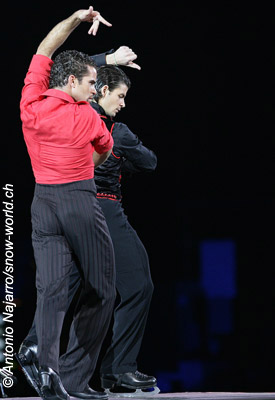 But usually when I talk to coaches their reaction is: "Ah, that's very difficult!" OK, it's difficult, but let's try it for now and before the competition, if you decide that it's too difficult, you can take it out.
But usually when I talk to coaches their reaction is: "Ah, that's very difficult!" OK, it's difficult, but let's try it for now and before the competition, if you decide that it's too difficult, you can take it out.
Yet Stéphane's flamenco was never skated clean. Now Jeremy Abbott writes in his Twitter that this will be the hardest program he's ever done and that he is praying he can pull this off.
If we always stay on the same level, we won't change anything in skating. For things to improve, we must start, little by little, to have skaters add more movement energy and movement language, and in the end skating will change. People will go to see the technical elements, of course the quadruple, the triple Axel, etc, but also the personality, the choreography, things that touch, music with movements and emotions in it. Why did Stéphane's flamenco touch people? Because he was speaking with his movements!
You sound very passionate about skating and its future. Did you like skating before you started working in this field?
Yeah, always. I always loved skating but I always felt that there was something missing. It's an amazing sport, it's very hard, very technical, but something was still missing. Skaters are skating to the music, they have a theme, they are speaking about something and they should develop it. They have to really show the artistic side of skating. I know it's very difficult, but I think it's possible.
Maybe you should open a school for skaters? Because according to what you say, you change only those who ask for your help.
My world right now is a dance world, so I'm not only a choreographer for skating. If I decided to be only a skating choreographer, I would love to start a school. I would make skaters understand that they have to take ballet classes from the beginning, like Russian skaters do. Ballet is good for the body, for presentation; it's very important! And you can immediately tell if a skater took ballet classes or not, it's very evident. I think it's a culture, a way of teaching from the very beginning.
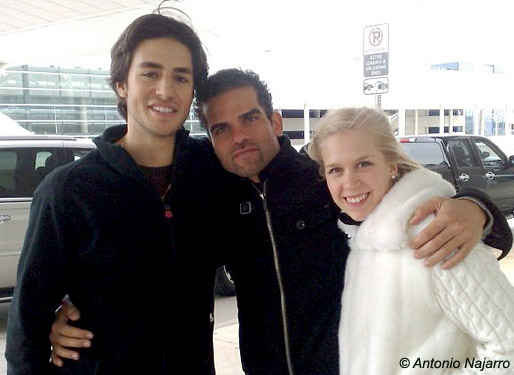
But I don't want to say that I need to open a new school for skaters, no, I only try to do my best and I put my heart in each program, from the very beginning until the end, always. I think a lot about the skater and I usually develop a very good relationship with the skaters I work with. I think it's very important to make them feel that they can do it. It's hard work, because many skaters are closed in by rules, expectations, medalsÂ…
Take Brian, for example. For me the timing to work with him was perfect, because he started to become more open. I was really, really happy with his work. We were in the studio about two hours a day, and he was listening, listening, and trying, trying. Amazing! It was a good experience.
There are the young promising Spanish skaters, Sonia Lafuente and Javier Fernández. Have you watched them skate?
Yes, of course. I'm very happy that they are improving so much. I think that can mean something, they are changing skating in Spain. And I'm happy about that since skating is not very popular in Spain. The strong base was missing, but now it's starting to change.
Would you consider helping them with choreography?
From the very beginning I had a chance to work with the top skaters; this is the way I work. But of course if they ask me, I will speak to them; I'm not closed to this option.
 From Israel you'll fly to Japan to choreograph a skating show. You have been choreographing skating shows in Japan before too, like "Champions on Ice". Are the shows you choreograph usually in Japan?
From Israel you'll fly to Japan to choreograph a skating show. You have been choreographing skating shows in Japan before too, like "Champions on Ice". Are the shows you choreograph usually in Japan?
Usually in Japan, yes. My skating manager worked with shows for Japan, so I started to work with him there. And now Japanese producers often contact me and want to work with me. There are a lot of skating shows in the US too, but they all have a very similar format and style. In Japan I can try different things, I can take risks, I can make skaters dance a lot. It's more open.
Will it be like your "Carmen on Ice", with a story line which goes throughout the whole show?
No, I will choreograph the opening and the closing of the show. There will be Japanese singers who are very famous in Japan, and I will create programs to their songs. I plan to do something very theatrical, very new, with chairs on the ice, something like "Chicago."
We talked a lot about the artistic side of skating, but figure skating is still a sport. There is always this discussion: what is more important in figure skating - "transitions", which is mostly your part of the work, or jumps?
I always say that the perfect solution would be if the skater did two programs; one with only technical elements and one with a more artistic side to it. That would be perfect. Both things are important. Of course the jumps are important but people will always remember the artist. Sure they will remember the quads, but when you are 60 years old you will remember something that touched you, the feeling, the movement, the music, the costume...



